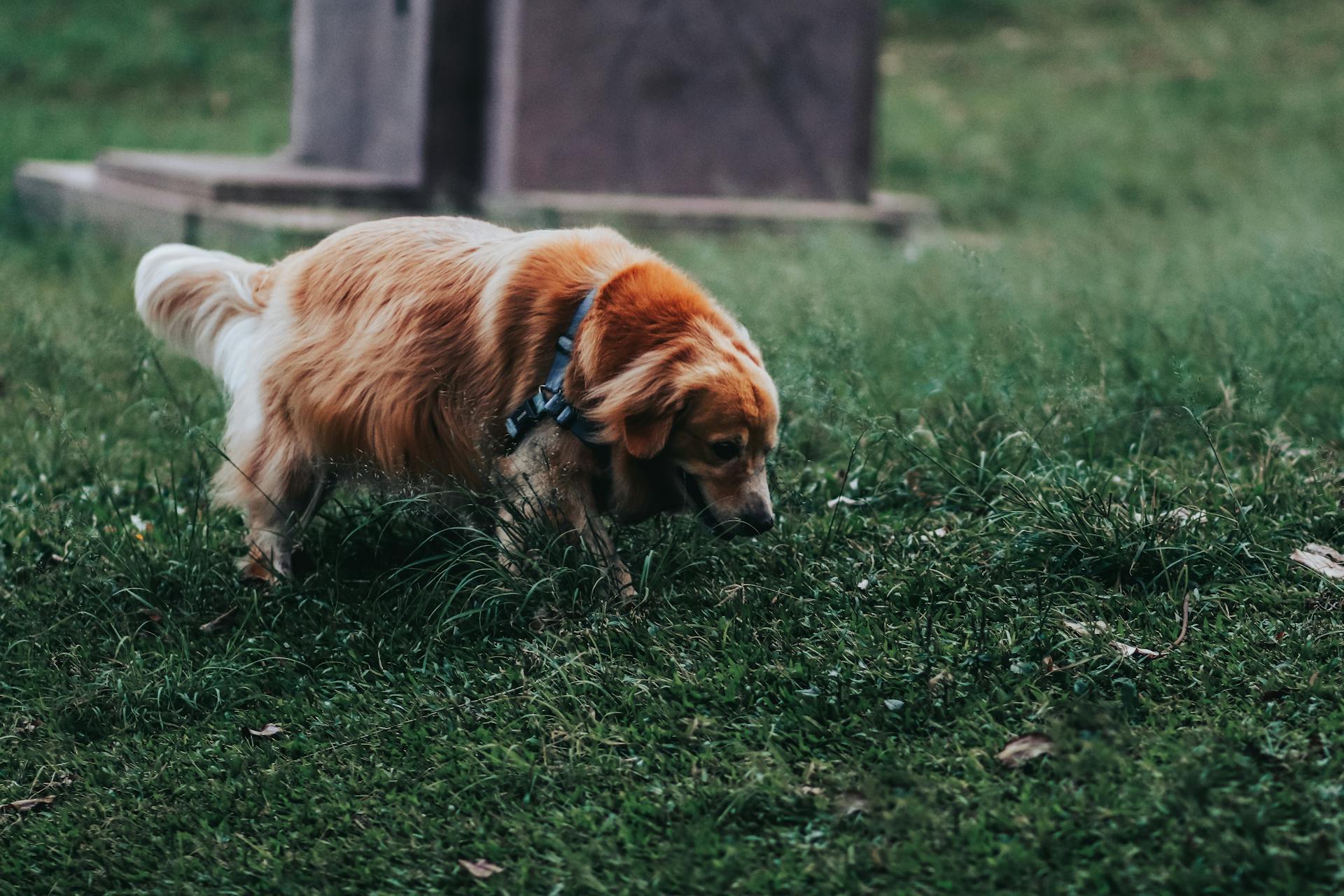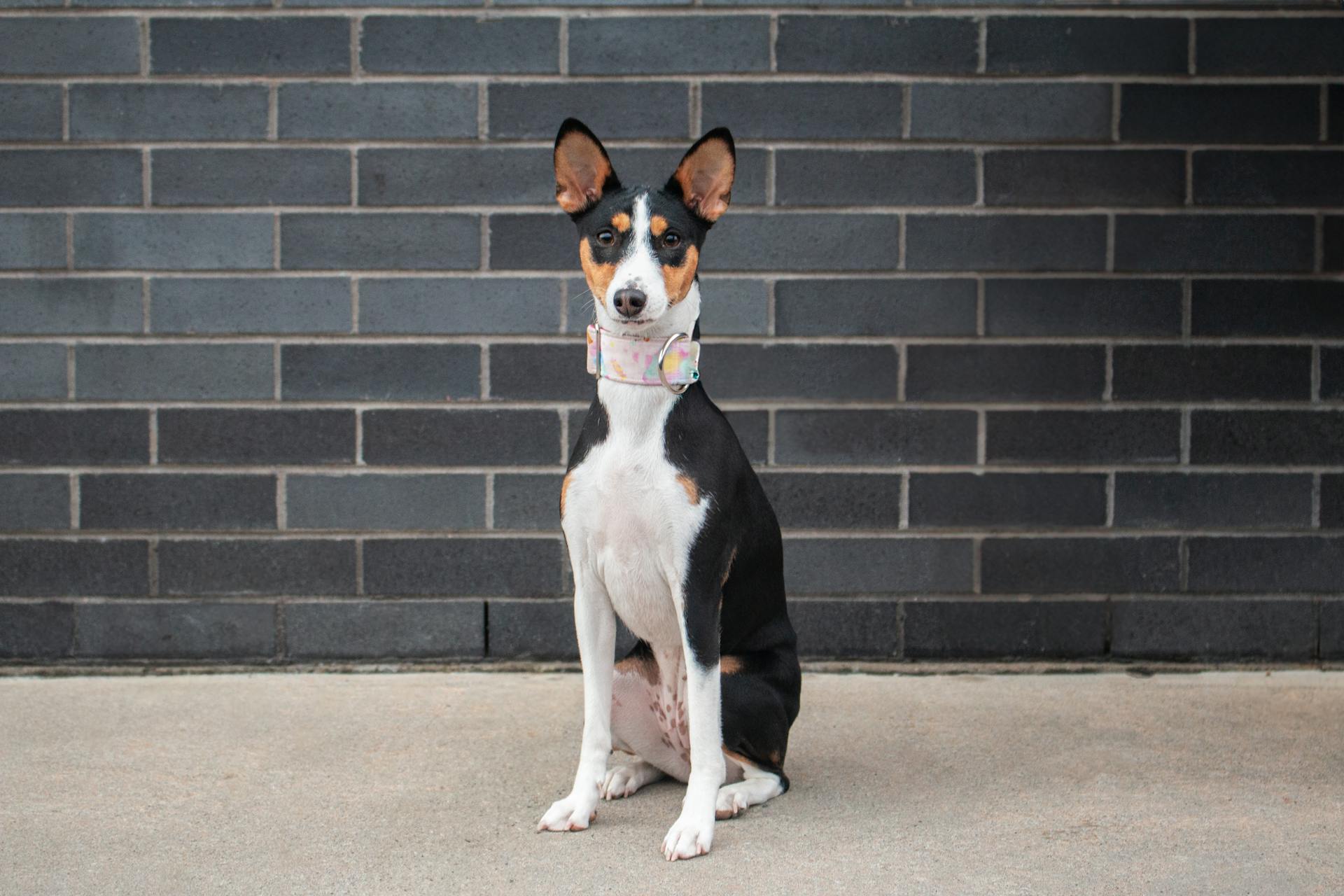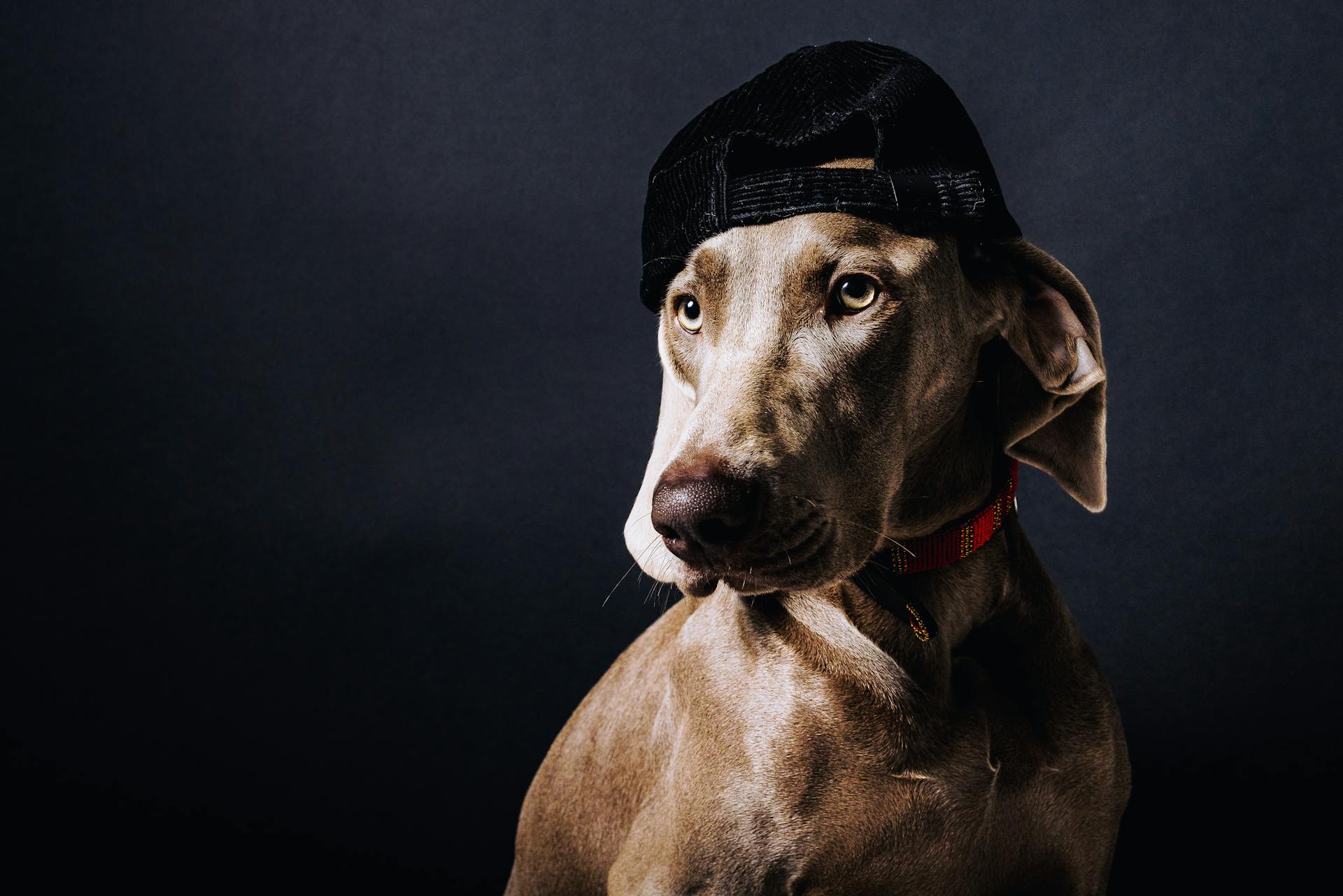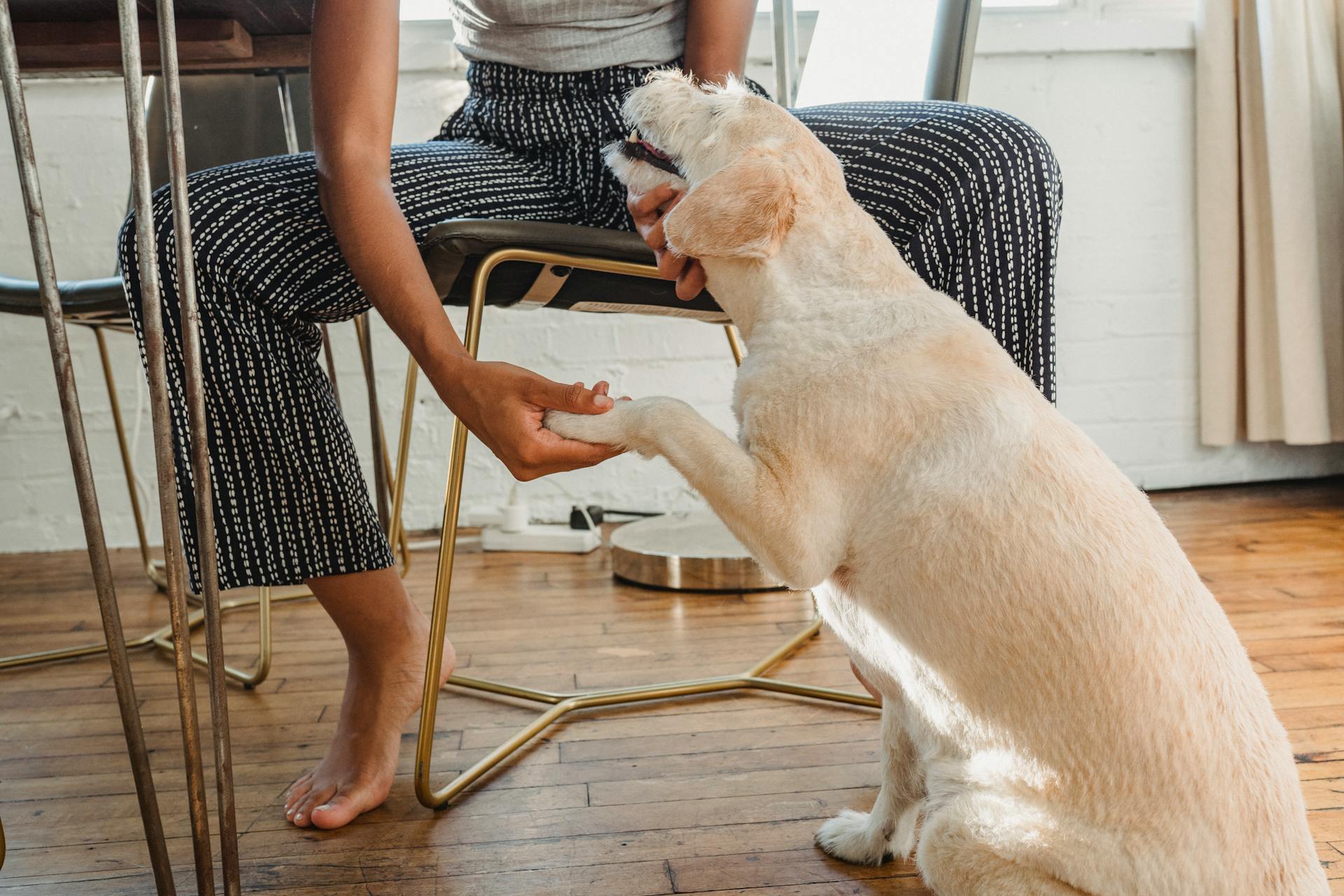
A female dog in heat can be a handful, but understanding what to expect can make all the difference.
She'll likely become more affectionate and loving, as her hormones surge.
Her vulva will swell and change color, making it more noticeable.
She may also start to urinate more frequently, as her body tries to attract a mate.
This behavior can be intense, with some dogs becoming more vocal and restless.
It's essential to keep her indoors and away from intact males to prevent unwanted breeding.
Canine Estrous Cycle Stages
A female dog's heat cycle is a natural process that can be divided into four stages: proestrus, estrus, diestrus, and anestrus. Each stage has distinct physical and behavioral changes that you should be aware of.
During the proestrus stage, which usually lasts around nine days, a female dog's body starts to produce hormones that cause physical and behavioral changes. Her vulva will start to swell, and she'll become attractive to male dogs.
On a similar theme: Dog Names Female Start with S
The estrus stage is when a female dog is most fertile, lasting about five days, but it can vary depending on the breed. This is the time when her vulva will be swollen, and she'll have a bloody discharge.
The diestrus stage is when a female dog's hormones start to return to normal, lasting about two months. During this time, her vulva will go back to normal, and she'll no longer be attractive to male dogs.
The anestrus stage is the period when a female dog's body is not producing hormones, and she's not fertile, lasting about three months.
Here's a quick rundown of the stages:
Common Behaviors
A female dog in heat will often display certain behaviors that are hard to ignore. One of the most common signs is increased vocalization, which can range from barking to whining and howling.
Female dogs in heat will also urinate more often than usual, as if trying to leave a scent for potential suitors. This behavior is often accompanied by flagging, where the dog raises her tail to one side.
For more insights, see: How Often Does a Female Dog Bleed
Increased energy is another common behavior, with dogs becoming more active and restless. Some dogs may also become more nervous and anxious, pacing and panting more than usual.
Aggression is also a possibility, particularly towards male dogs. It's essential to keep an eye on your dog's behavior and take steps to prevent unwanted interactions.
Here are some common behaviors to look out for:
- Increased vocalization
- Increased urination
- Flagging
- Increased energy
- Nervousness
- Aggression
Some dogs may become more affectionate and clingy during this time, while others may exhibit nesting behavior, creating a safe space for potential puppies. Excessive licking of the genital area is also a common behavior, as the dog tries to relieve discomfort caused by increased oestrogen levels.
Mounting and thrusting are also possible behaviors, as the dog tries to mimic mating behavior. It's essential to keep your dog safe and prevent unwanted interactions with male dogs.
5 Home Remedies
Female dogs in heat may feel uncomfortable and restless due to hormonal changes in their body. They may experience pain from menstrual cramps, although it's not as excruciating as period pains in humans.
Being in heat is mentally and physically taxing to your dog. Knowing what to do when your dog is in heat will help in alleviating the discomfort she feels.
Here are some helpful tips you can follow:
Being in heat is not a pleasant experience for your dog. You can provide a comfortable and quiet space for her to rest.
Providing a warm compress can help ease her discomfort. This can be done by wrapping a warm washcloth around her abdomen.
You can also try providing a safe and secure area for her to escape to when she's feeling anxious or overwhelmed.
A change of environment can help calm her nerves and reduce her stress levels.
Providing plenty of exercise and mental stimulation can help distract her from the discomfort she's feeling.
Physical Signs and Symptoms
Physical signs of a female dog in heat are unmistakable. You'll notice a swollen vulva, which can be accompanied by a bloody or straw-colored discharge. This discharge can last up to three weeks and initially appears dark before lightening in color over time.
Related reading: Why Does My Female Dog Have Discharge
A female dog in heat will also exhibit changes in her behavior, such as increased urination, which she may use to attract a male dog. You may also notice her flagging, or raising her tail to one side, as a way of signaling her readiness to mate. Excessive licking of the genital area is another common symptom.
Some other physical signs of a female dog in heat include changes in her body posture and tail position. Her tail may be tucked in or raised to the side, especially when touched. You may also notice a change in her energy level, with some dogs becoming more active and others becoming more anxious.
Body Posture Change
As you monitor your dog's behavior during her heat cycle, you'll notice changes in her body posture that signal she's ready to mate. One of the most noticeable signs is a change in her tail position.
During the second phase of the heat cycle, also known as estrus, your dog may slightly raise and move her tail to the side, especially when touched. This is a clear indication that she's receptive to male dogs.
Discover more: Female Dog Heat Cycle Chart

You'll also notice that your dog's vulva becomes swollen, and she may exhibit excessive licking of the genital area. This is a natural response to the hormonal changes occurring during her heat cycle.
A swollen vulva is one of the most obvious physical signs that your dog is in heat. It's essential to monitor this change closely, as it can indicate that your dog is ready to mate.
As your dog's body undergoes these changes, she may become more aggressive or domineering among her other pets. This is a common behavior during the heat cycle, and it's crucial to keep a close eye on her interactions with other animals.
Here are some key physical signs to look out for during your dog's heat cycle:
- Bloody or straw-colored discharge from the vulva
- Swollen vulva
- Excessive licking of the genital area
- Change in tail position
Physical Signs
Physical signs of a female dog in heat are quite noticeable. A swollen vulva is one of the most obvious signs, and it can be accompanied by a bloody or straw-colored discharge.
For more insights, see: Female Dog Whelping Signs
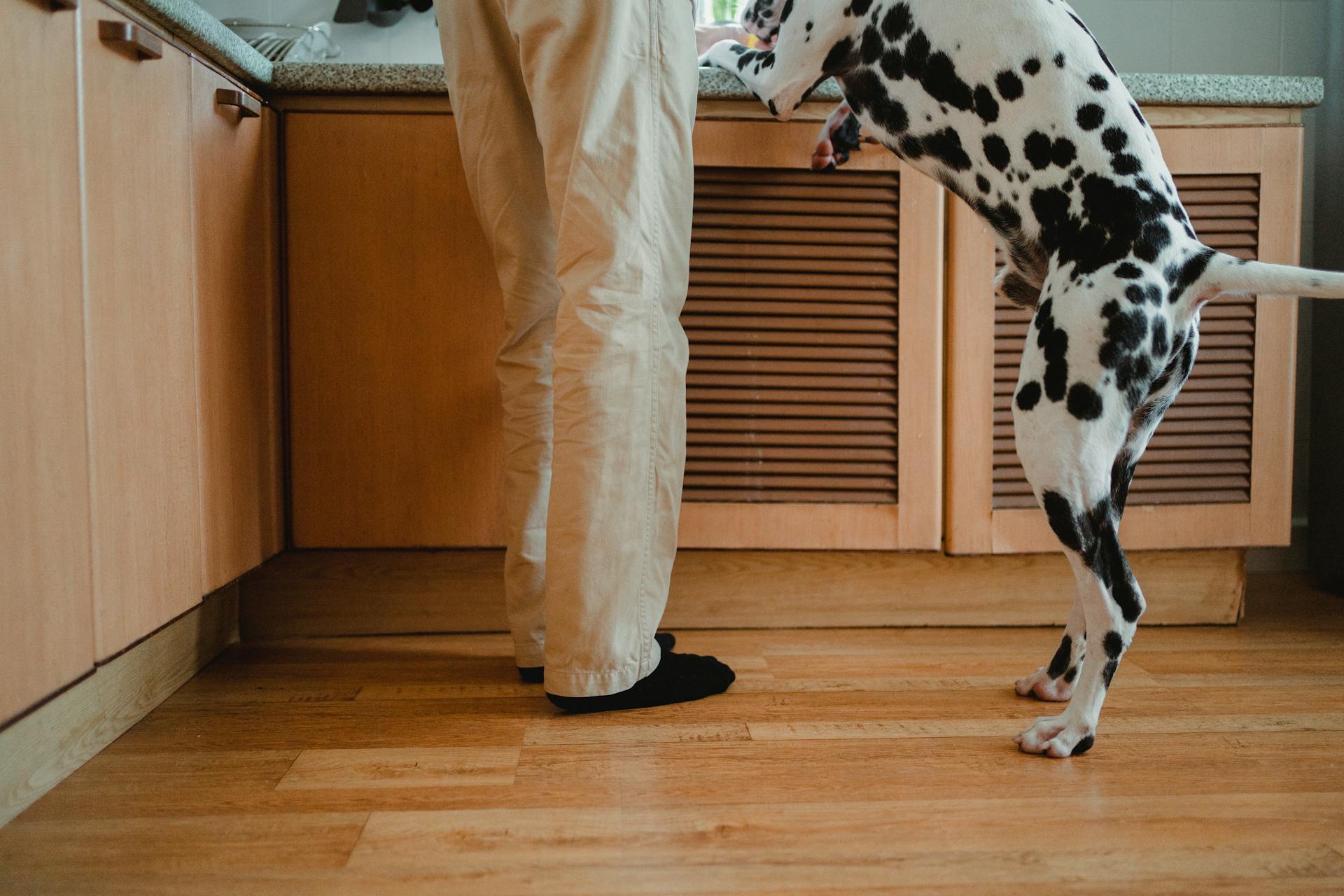
This discharge can last for up to three weeks and initially tends to be dark, gradually becoming lighter as time passes. The amount of discharge can vary from dog to dog, and some dogs may not even show any signs if they have long fur.
You may also notice your dog urinating more frequently, which is a normal part of the heat cycle. In addition, she may exhibit behaviors such as excessive licking of the genital area and being very receptive to male dogs.
Here are some common physical signs of a female dog in heat:
- Bloody or straw-colored discharge from the vulva
- Swollen vulva
- Excessive licking of the genital area
- More frequent urination
Keep in mind that every dog is different, and not all dogs will exhibit all of these signs. If you're unsure about your dog's heat cycle, it's always best to consult with a veterinarian for advice.
Symptoms
As you're trying to figure out if your dog is in heat, it's essential to know the signs to look out for. A dog in heat will often exhibit physical symptoms, such as a bloody or straw-colored discharge from the vulva and a swollen vulva.
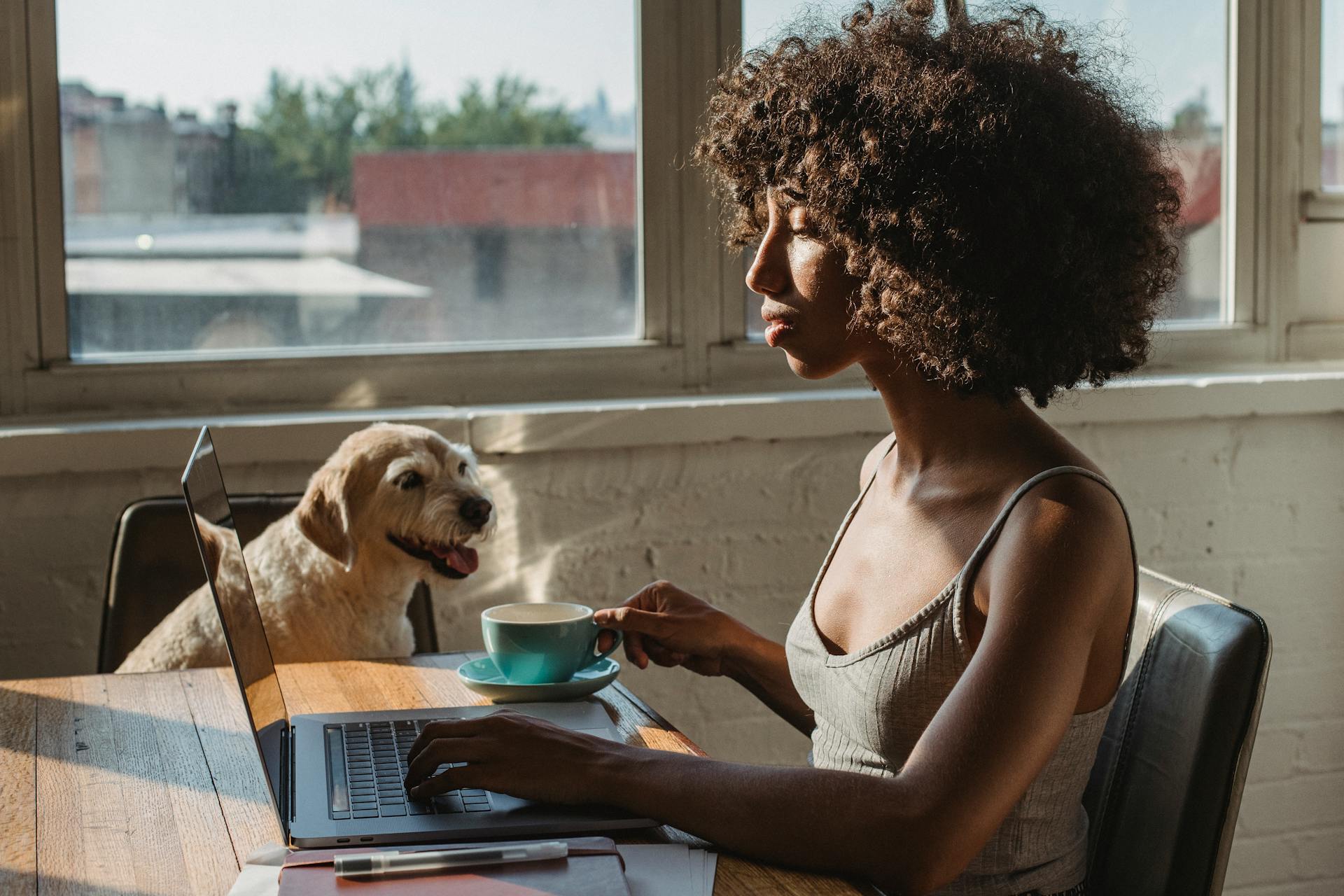
This discharge can be quite noticeable, especially if your dog has short hair or is a smaller breed. It's essential to keep an eye on this symptom, as it can be a sign that your dog is ready to mate.
In addition to physical symptoms, dogs in heat may also display behavioral changes, such as excessive licking of the genital area and being very receptive to male dogs. If you notice these changes, it's crucial to take action to prevent an unwanted pregnancy.
Here are some common symptoms to watch out for:
- Bloody or straw-colored discharge from the vulva
- Swollen vulva
- Excessive licking of the genital area
- Being very receptive to male dogs
- More frequent urination
- Aggressive, agitated and nervous behavior
- Change in your dog’s tail position
Keep in mind that every dog is different, and some may exhibit more subtle symptoms. If you're unsure whether your dog is in heat, it's always best to consult with a veterinarian for a professional diagnosis.
Attracting and Mating
During a female dog's heat cycle, she'll often display behaviors that signal her receptiveness to male dogs. These behaviors are designed to attract a mate.
One of the most noticeable behaviors is flagging, where she'll lift her tail to the side and expose her genital area. This is a clear sign that she's in heat.
Female dogs in heat will also exhibit increased vocalization, which can range from whining to barking. This is a way for her to communicate her availability to male dogs.
In addition to these behaviors, she'll release pheromones, chemical signals that attract male dogs. These pheromones are a key part of her mating process.
As she becomes more receptive to mating, she'll become more friendly and open to attention from male dogs. She might even "flirt" by moving her tail to the side and allowing them to sniff and lick her rear end.
Worth a look: Signs That a Female Dog Has Mated
Health and Safety
Providing a comfortable place for your female dog to rest during her heat cycle is crucial for her emotional well-being. This quiet space will help her feel safe and secure.
You should keep your female dog away from male dogs during her heat cycle to prevent unwanted pregnancies. It's surprising how quickly a male dog can sense a female in heat and become persistent.
Monitoring your female dog's behavior is essential, and if you notice any changes, contact your veterinarian for advice. This proactive approach will ensure your dog's health and safety.
Here are some key signs that require immediate veterinary attention:
- Changes in behavior
Signs of Pet Pregnancy
As a pet owner, it's essential to recognize the signs of pet pregnancy to ensure the health and well-being of both your pet and the unborn puppies.
If your dog is in heat, she can get pregnant, so keep an eye out for the classic symptoms, which include acting funny and showing changes in behavior.
The cycle when a dog is in heat is also called the 4-stage estrus cycle in dogs, and it's a crucial time to take precautions if you're not planning for puppies.
On a similar theme: Original Female Dog Names
Your dog might start to show more interest in males and may even try to escape to mate, so make sure to keep her safe and secure during this time.
If you suspect your dog is pregnant, monitor her weight gain and appetite, as these are common indicators of an upcoming litter.
Average Age at Reproduction
Female dogs typically begin their first heat cycle at around 6 months old, but some may start as early as 4 months.
Breeding a dog too early can lead to complications, especially if the mother is still underdeveloped.
It's recommended to wait until a female dog has had her third heat cycle, which usually occurs between 18-24 months old, before breeding her.
This allows her body to fully develop and prepare for the demands of pregnancy and childbirth.
Explore further: What Age Can You Breed a Female Dog
Frequency and Duration
Female dogs in heat can be quite unpredictable, but understanding their frequency and duration can help you prepare for what's to come.
On average, a sexually mature female dog is in heat twice a year, around 6 months apart. However, small dogs experience heat more frequently than larger breeds, going in heat 3–4 times a year.
The length of a dog's heat cycle can vary, but it usually lasts around 2–3 weeks. For some dogs, it may be shorter, lasting around 1 1/2–2 weeks, while others may experience a longer heat cycle.
Young dogs often have irregular heat cycles after their first heat, but this should become more stable as they reach maturity. It can take up to 18 months for some dogs to have a regular heat cycle.
Irregular heat cycles can be a sign of underlying health issues, so it's essential to consult with a vet if you notice any abnormalities.
Take a look at this: Heat Cycle of Female Dog
Frequently Asked Questions
Are female dogs more emotional when in heat?
Female dogs can exhibit emotional changes, such as mood swings and whining, due to hormonal fluctuations during their heat cycle. This behavior is not a reflection of their temperament, but rather a natural response to their reproductive instincts.
Sources
- https://www.tehamacountydogtrainingcenter.com/2022/11/28/common-behaviors-of-a-female-dog-during-heat/
- https://www.ukpets.com/blog/6-common-behaviours-of-a-female-dog-in-heat/
- https://pawious.com/blogs/learning-and-helpful-information/how-to-handle-the-dog-heat-cycle
- https://www.petcubes.com/blogs/dog-psychology/female-dog-in-heat-behavior
- https://wamiz.co.uk/dog/advice/14993/understanding-a-female-dogs-behaviour-when-she-is-in-heat
Featured Images: pexels.com
